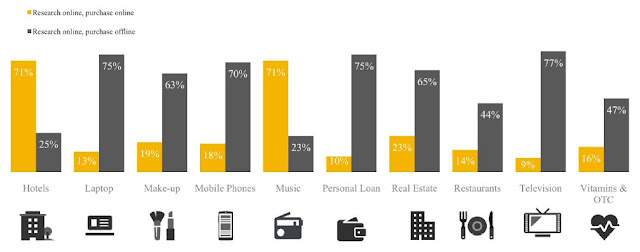In contrast to 4 categories for online purchase, there are 12 categories at 50% or more which lead to offline purchase.
With "eCommerce" becoming the buzzword in recent years, do Malaysians buy everything online?
The short answer is "Not exactly", read on to find out why.
According to Consumer Barometer by Google, 80% of Malaysians conduct online research before purchase. Yes, better be safe than sorry.
30% Malaysians will then proceed with online purchase, and guess what? The other 51% will walk into shopping malls, retail, point of sales to complete their purchase journey.
This comes as no surprise though, as it is hugely publicised that only 1-2% of retail transactions are made online in this part of the world.
So, let's drill down the Consumer Barometer data by looking at which categories do Malaysians:
(a) Research online, then purchase online
(b) Research online, then purchase offline
Note: Thanks to Su Ann for the charts above, derived from Consumer Barometer, click to enlarge.
The top 5 categories for research online, purchase online are:
In contrast to 4 categories for online purchase, there are 12 categories at 50% or more which lead to offline purchase.
I have spoken to a FMCG brand owner slash distributor lately and according to them, "Last year was good, but online is slow since early this year (2017) - it's promo-driven, but our offline distribution is still steady all this while." For the record, they distribute to online channels like Lazada, 11street etc. and offline channels like AEON, Giant etc.
So, this is a 3-points summary I can make here:
#1. Online presence (for research) is crucial for everyone, but e-commerce capability (for purchase) is not a must. Don't believe? Just refer to the charts above.
#2. To start e-commerce, it can be as simple as showrooming to serious effort like SEO, SEM, content marketing, just make sure you are there when consumers are doing their research online.
#3. Many brands (especially for those with offline channels) tend to measure online sales as the main KPI but shouldn't it be how online presence influences consumers' buying decision?
Don't just blindly follow the e-commerce bandwagon, it's more important to convince your target consumers via online searches and content first.
The short answer is "Not exactly", read on to find out why.
According to Consumer Barometer by Google, 80% of Malaysians conduct online research before purchase. Yes, better be safe than sorry.
30% Malaysians will then proceed with online purchase, and guess what? The other 51% will walk into shopping malls, retail, point of sales to complete their purchase journey.
This comes as no surprise though, as it is hugely publicised that only 1-2% of retail transactions are made online in this part of the world.
So, let's drill down the Consumer Barometer data by looking at which categories do Malaysians:
(a) Research online, then purchase online
(b) Research online, then purchase offline
Note: Thanks to Su Ann for the charts above, derived from Consumer Barometer, click to enlarge.
The top 5 categories for research online, purchase online are:
- Flights (83%)
- Hotels (71%)
- Music (71%)
- Ground Travel (70%)
- Clothing & Footwear (37%)
- Television (77%)
- Laptop (75%)
- Personal Loan (75%)
- Mobile Phones (70%)
- Real Estate (65%)
In contrast to 4 categories for online purchase, there are 12 categories at 50% or more which lead to offline purchase.
Moral of the story (data)
I have spoken to a FMCG brand owner slash distributor lately and according to them, "Last year was good, but online is slow since early this year (2017) - it's promo-driven, but our offline distribution is still steady all this while." For the record, they distribute to online channels like Lazada, 11street etc. and offline channels like AEON, Giant etc.
So, this is a 3-points summary I can make here:
#1. Online presence (for research) is crucial for everyone, but e-commerce capability (for purchase) is not a must. Don't believe? Just refer to the charts above.
#2. To start e-commerce, it can be as simple as showrooming to serious effort like SEO, SEM, content marketing, just make sure you are there when consumers are doing their research online.
#3. Many brands (especially for those with offline channels) tend to measure online sales as the main KPI but shouldn't it be how online presence influences consumers' buying decision?
Don't just blindly follow the e-commerce bandwagon, it's more important to convince your target consumers via online searches and content first.















COMMENTS